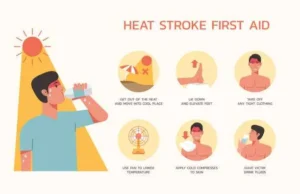Heat Stroke and Sunstroke
As summer temperatures rise, the risk of heat-related illnesses, including heat stroke and sunstroke, becomes a serious concern. Understanding the symptoms, warning signs, and effective treatments for these conditions is crucial for staying safe in the heat. This article provides comprehensive information on heat stroke and sunstroke, helping you recognize the dangers and respond effectively.

heat stroke symptoms
signs of heat stroke
heat stroke treatment
sun stroke symptoms
What is Heat Stroke?
Heat stroke is a severe heat-related illness that occurs when the body can no longer regulate its temperature. Heat Stroke typically results from prolonged exposure to high temperatures, particularly in combination with dehydration. Without prompt treatment, heat stroke can damage the brain, heart, kidneys, and muscles, and can be life-threatening.

heat stroke symptoms
signs of heat stroke
heat stroke treatment
sun stroke symptoms
Key Symptoms of Heat Stroke
Recognizing the symptoms of heat stroke is essential for early intervention. The primary heat stroke symptoms include:
- High Body Temperature: A core body temperature of 104°F (40°C) or higher is a critical indicator.
- Altered Mental State: This may include confusion, agitation, slurred speech, irritability, delirium, seizures, or even coma.
- Nausea and Vomiting: The affected person may feel sick to their stomach or vomit.
- Flushed Skin: Skin may become red as the body temperature rises.
- Rapid Breathing and Heart Rate: An increased pulse and rapid, shallow breathing are common.
- Headache: A throbbing headache can indicate heat stroke.

heat stroke symptoms
signs of heat stroke
heat stroke treatment
sun stroke symptoms
Warning Signs of Heat Stroke
In addition to the key symptoms, there are several warning signs of heat stroke to watch for:
- Hot, Dry Skin: Unlike other heat-related conditions, sweating may stop, and the skin can become hot and dry.
- Dizziness and Fainting: Feelings of lightheadedness or actual fainting can occur.
- Lack of Sweating: Despite the heat, the affected person may not sweat, indicating the body’s cooling mechanisms have failed.
Sunstroke Symptoms
Sunstroke is another term often used interchangeably with heat stroke, though it specifically refers to heat stroke caused by direct sun exposure. Sunstroke symptoms mirror those of heat stroke, including:
- Severe headache: Often a result of prolonged exposure to direct sunlight.
- Dizziness and confusion: The individual may appear disoriented or struggle to concentrate.
- High body temperature: Similar to heat stroke, the body temperature can soar dangerously high.
- Nausea and vomiting: Feeling sick or vomiting due to overheating.
- Rapid heartbeat and breathing: Increased pulse and quick breathing.

heat stroke symptoms
signs of heat stroke
heat stroke treatment
sun stroke symptoms
Heat Stroke Treatment
Immediate heat stroke treatment is crucial to prevent serious complications. Here’s what to do:
- Call Crisis Administrations: Heat stroke is a health-related crisis. Dial crisis benefits right away.
- Move to a Cooler Environment: Get the person out of the sun and into a cool, shaded, or air-conditioned space.
- Cool the Body: Use any available means to lower the person’s body temperature. Methods include:
- Immersing in a tub of cool water.
- Applying ice packs to the armpits, neck, and groin.
- Using cool, wet cloths or sponges on the skin.
- Hydrate: If the person is conscious and able to drink, provide water or sports drinks. Avoid caffeine or alcohol, which can worsen dehydration.
- Monitor Continuously: Keep a close watch on the individual’s condition until emergency personnel arrive.
Preventing Heat Stroke and Sunstroke
Prevention is the best strategy for avoiding heat stroke and sunstroke. Here are some tips:
- Stay Hydrated: Drink plenty of fluids, especially water, throughout the day.
- Wear Appropriate Clothing: Light-colored, loose-fitting clothing helps keep the body cool.
- Limit Sun Exposure: Avoid direct sun exposure during peak hours (10 a.m. to 4 p.m.).
- Use Sunscreen: Protect your skin from harmful UV rays.
- Take Breaks: If you’re working or exercising in the heat, take regular breaks in a cool place.
- Acclimatize Gradually: Allow your body to get used to high temperatures gradually.
Conclusion
Heat stroke and sunstroke are serious conditions that require immediate attention. By recognizing the symptoms and warning signs early and taking prompt action, you can protect yourself and others from the dangerous effects of extreme heat. Stay informed, stay hydrated, and stay safe this



